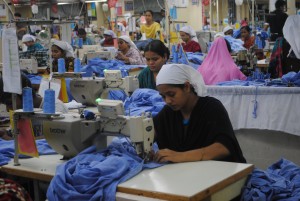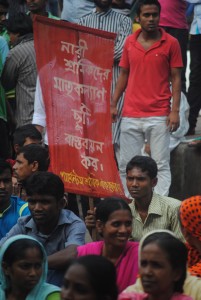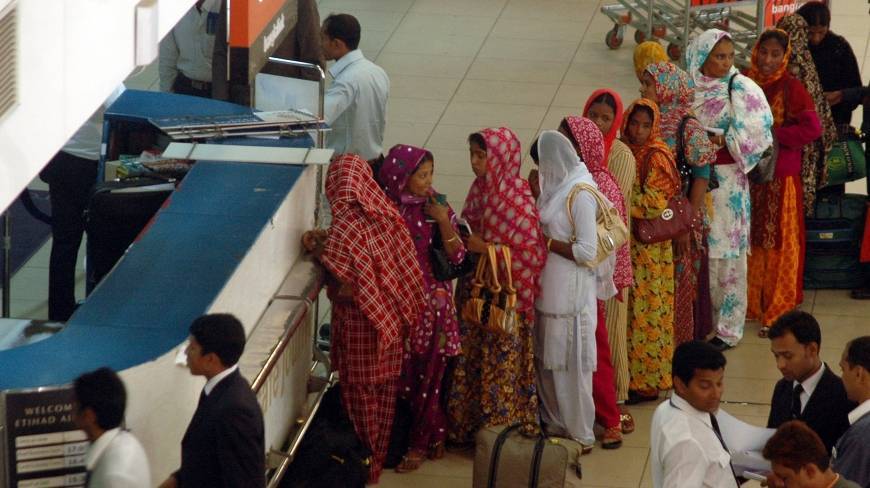
International Women’s Day also once known as International Working Women’s Day gives us an opportunity to think about workers’ rights in the garment industry from the perspective of the majority female workforce and the female migrant workers who work abroad as domestic workers. Since Rana Plaza, there has been a laudable focus on workplace safety. There are two international safety agreements that are leading efforts to inspect the electrical, fire, and structural safety of buildings; however, these efforts are limited in addressing key issues impacting the workplace safety of women workers and their overall rights.
In the summer of 2013, I interviewed survivors of the Rana Plaza tragedy and learned that pelvis fractures, injuries to reproductive organs and urinary tracts were common due to the building collapsing on their bodies. Media and advocates focused on limbs lost and campaigns to get prosthetics, but there was no mention of the impact on women’s reproductive health or inability to maintain marital relations. Women confided to me that they feared their husbands would abandon them: neither can they work nor can they bear any children. The majority of the women working in the industry are at the peak of childbearing age, between their teens and thirties, and so, this fear is a real concern.
The focus solely on workers’ rights, and not the specific way in which women workers are impacted has resulted in the failure of providing reproductive and also mental health services for women. Still, we have not researched the ways in which women are coping in their families, and how their social status has diminished due to their injuries. Working in the garment industry gave women a certain level of economic freedom because they were able to contribute income to the joint households. To resume to a dependent status on their family members surely will cause emotional and psychological distress.

Aside from the survivors of Rana Plaza, women workers’ needs and concerns are routinely ignored in the workplace, such as maternity leave, child care on site, and sexual and verbal harassment. Many working women still are required to maintain household duties such as cooking, cleaning, and child care, and workers’ advocates need to think about women’s rights beyond the factory. Conscientious and business savvy owners provide on-site child care because they know if a worker’s child is nearby she will be productive and will not be absent. In an industry driven by targets and deadlines, absences hurt the bottom line and it is cheaper to provide child care onsite. Some forward-thinking owners also provide free schools for the children of garment workers as a benefit.
Trade unions have benefited women workers. Women workers I have interviewed have used the trade union structure to collectively obtain maternity benefits. This is probably why women workers are unions’ most vocal supporters. While Bangladesh labor law allows for maternity leave benefits, it is rarely enforced in the garment industry. As soon as an owner learns a worker is pregnant, she is terminated. Even if she is not, she is not given the legally owed benefits, which can have deadly consequences. In one case, the mother was unable to afford quality prenatal care, because her employer did not provide her maternity leave benefits, and as a result, she died during childbirth.

Also not often discussed is the work-life span of women workers. Sekender Ali Mina, Executive Director of Safety & Rights, shares “there is no systemic investigation on when women leave the workforce or programs to assist with the transition. After their labor is used in their youth, they are forgotten.” But, he estimates by their thirties, women leave the garment industry. Younger workers seeking jobs are eager to replace them. Older women are capable of working; yet, there are few programs to provide any safety net once they leave garment work or programs to retrain them to do other work. Back home, they are often viewed as an economic burden.
Outside of the garment industry, in designing migrant worker programs, the Bangladesh Government fails to take into consideration unique issues women workers face. In the recent MOU with Saudia Arabia (KSA) where female workers will be hired as domestic workers, the Government has not taken steps to protect the rights of women. Human rights lawyer and program manager with Manusher Jonno Foundation, Sarowat Binte Islam, notes that the Government should investigate why other countries have withdrawn female workers from KSA and should have discussed remedies for those issues with them. These programs as they stand may violate ILO Migration for Employment Convention since the jobs are restricted based on sex and the remuneration is lower than that provided to nationalities from other labor sending countries. Some steps it could have taken are to demand wages on par with other migrant sending countries, designating safe houses in case of harassment by an employer, contacts for social service organizations, mobile phone so that women can call home for free or programs to allow women to meet each other so that they are not isolated. Also, Ms. Islam recommends skills training for jobs other than domestic work.

Bangladeshi women workers find themselves vulnerable in the export oriented industries of the garment sector, as well as migrant workers, and a whole host of other workplaces including as domestic workers. In conceptualizing workers’ rights and designing workers’ rights programs, if we use a gender lens, we can begin to identify and address some of the issues women encounter at their workplaces.





It’ so very imp. to look through gender perspective, specially in the case of women migrant worker. The reason mostly; they are most often sexually assaulted or sold to prostitution. There shud be vigilance, strict rules of hire, overseers and accountability. The article is very inclusive about what shud be the rights of workers and awareness of the organizers.
[…] Workers Rights in Bangladesh Through a Gender Lens […]